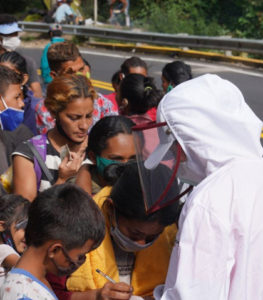Venezuelans on the move again
A new wave of Venezuelan migrants is leaving the country again to look for work and new lives as neighbouring countries reopen their economies. But the pandemic is making their route through South America tougher.
At least five million Venezuelans have left the country since 2014, escaping hyperinflation, food shortages and some of the lowest wages in the hemisphere.
 But the exodus stalled in April as countries like Colombia, Ecuador and Peru imposed restrictions on economic activity to slow the spread of the COVID-19 virus coronavirus. The move led to business closures and massive job losses.
But the exodus stalled in April as countries like Colombia, Ecuador and Peru imposed restrictions on economic activity to slow the spread of the COVID-19 virus coronavirus. The move led to business closures and massive job losses.
Now, as these economies reopen, thousands of Venezuelan migrants are again on the roads of South America seeking work.
Their exodus amounts to world’s second-largest recent displacement of people. Only war-torn Syria has produced more migrants and refugees in the past decade.
But the pandemic is making their travels through South America difficult.
Colombia closed border crossings with Venezuela to prevent the spread of the coronavirus, forcing migrants to take dirt trails across the border that are under the control of drug trafficking groups.
Shelters for the poorest migrants have also been shut down by officials, who are trying to prevent large gatherings.
Immigration officials in Colombia announced that in September, about 200,000 Venezuelans would be able to enter the country in the following months.
Many people leave Venezuela because of huge wage disparities, where the minimum wage is currently less than $US2 a months.
While in Colombia and Peru, a worker on minimum wage can make around $250 a month.
In 2018 the exodus of migrants from Venezuela became a humanitarian crisis.
Hundreds of thousands of people fled the nation’s economic disaster that has seen people scrounging for food and other necessities of daily life.
The movement of refugees at the time threatened to overwhelm neighbouring countries.
Brazil has sent troops to border crossings and Peru tightened entry rules for Venezuelans, requiring them to carry passports instead of just national ID cards.
The UN estimates 5 million Venezuelans have fled since 2015 with Columbia the major host country.
The South American country has been caught in a downward spiral for years with growing political discontent further fuelled by skyrocketing hyperinflation, power cuts and shortages of food and medicine.
President Nicolás Maduro was first elected in April 2013 after the death of his socialist mentor and predecessor in office, Hugo Chávez. At the time, he won by just 1.6 percentage points.
During his first term, the economy went into freefall and many Venezuelans blame him and his socialist government for the country’s decline.
Maduro was re-elected to a second six-year term in May 2018 in controversial elections, which most opposition parties boycotted.
Many candidates had been barred from running while others had been jailed or fled the country for fear of being imprisoned, and the opposition parties argued that the poll would be neither free nor fair.
Mr Maduro’s re-election was not recognised by Venezuela’s opposition-controlled National Assembly, which labelled Mr Maduro a “usurper” and argued that the presidency was vacant.
Venezuela’s problems go back a long way. But, it is President Maduro and Hugo Chávez who are the target of much of the current anger.
When Mr Chávez became president in 1999, he promised, among other things, to drive down Venezuela’s huge levels of inequality.
While he managed to reduce inequality during his time in power, some of the socialist polices he brought in backfired.
His price control policy, aimed at making basic goods more affordable to the poor, meant that many Venezuelan businesses stopped production because they no longer made a profit, eventually resulting in shortages.












